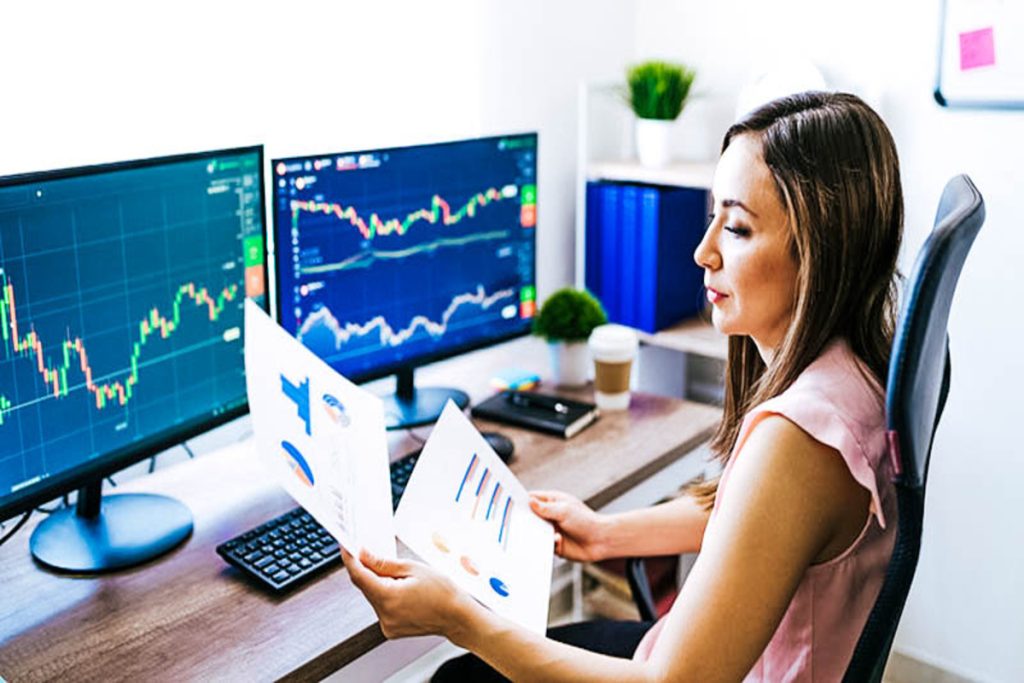
How to Create a Forex Trading Plan: A Comprehensive Guide
12/07/2024
Understanding Forex Liquidity: A Comprehensive Guide
13/07/2024The Best Time to Trade Forex: A Comprehensive Guide

Business analyst looking at a graph chart while working from home as a freelance. Professional young woman buying stocks
The Best Time to Trade Forex: A Comprehensive Guide
Introduction to Forex Trading Hours
The Forex market operates 24 hours a day, five days a week, providing traders with the flexibility to trade at any time. However, not all trading hours are created equal. Different times of the day offer varying levels of liquidity, volatility, and trading opportunities. Understanding the best times to trade Forex can significantly impact your trading success. This comprehensive guide will explore the key trading sessions, their characteristics, and the optimal times for trading various currency pairs. Whether you’re a beginner or an experienced trader, this article will provide valuable insights into maximizing your trading performance by choosing the best trading hours.

Understanding Forex Trading Sessions
The Forex market is divided into four major trading sessions: Sydney, Tokyo, London, and New York. Each session has unique characteristics influenced by the regional financial centers, economic activity, and market participants.
1. Sydney Session
The Sydney session opens the Forex trading week. Although it is the smallest of the major trading sessions, it sets the tone for the week ahead.
- Opening Hours: 10 PM to 7 AM GMT
- Major Currency Pairs: AUD/USD, NZD/USD
- Characteristics: Low volatility, lower liquidity, gradual price movements
2. Tokyo Session
The Tokyo session, also known as the Asian session, overlaps with the Sydney session for a few hours, adding to the market’s activity.
- Opening Hours: 12 AM to 9 AM GMT
- Major Currency Pairs: USD/JPY, EUR/JPY, AUD/JPY
- Characteristics: Moderate volatility, increased liquidity compared to the Sydney session, significant movements in yen pairs
3. London Session
The London session is the most active and liquid trading session, with numerous market participants and significant trading volumes.
- Opening Hours: 8 AM to 5 PM GMT
- Major Currency Pairs: EUR/USD, GBP/USD, USD/CHF
- Characteristics: High volatility, high liquidity, major market-moving news releases
4. New York Session
The New York session overlaps with the London session, creating a highly active period with substantial trading volumes and volatility.
- Opening Hours: 1 PM to 10 PM GMT
- Major Currency Pairs: EUR/USD, GBP/USD, USD/CAD
- Characteristics: High volatility, high liquidity, significant impact from US economic data releases
Optimal Times to Trade Forex
1. Overlapping Sessions
The overlapping periods between major trading sessions are the most active and volatile times in the Forex market. These periods offer increased trading opportunities due to higher liquidity and more significant price movements.
London-New York Overlap
- Time: 1 PM to 5 PM GMT
- Characteristics: Highest trading volume, high volatility, major economic news releases from both Europe and the US
- Best Pairs to Trade: EUR/USD, GBP/USD, USD/CHF, USD/CAD
Tokyo-London Overlap
- Time: 8 AM to 9 AM GMT
- Characteristics: Moderate trading volume, increased volatility in yen pairs
- Best Pairs to Trade: USD/JPY, EUR/JPY, GBP/JPY
2. High-Impact News Releases
Economic news releases and events significantly impact Forex prices, creating trading opportunities due to increased volatility. Traders often focus on high-impact news events from major economies, such as:
- US Non-Farm Payrolls (NFP)
- Federal Reserve Interest Rate Decisions
- European Central Bank (ECB) Policy Announcements
- Gross Domestic Product (GDP) Reports
- Inflation Data (CPI, PPI)
3. Best Days to Trade
The Forex market exhibits different characteristics on different days of the week. Generally, the middle of the week offers the best trading opportunities due to higher volatility and trading volumes.
Monday
- Characteristics: Slow start, lower volatility, market reaction to weekend news
- Best Pairs to Trade: Cautious trading recommended, focus on developing trends
Tuesday to Thursday
- Characteristics: High volatility, significant trading volumes, major economic data releases
- Best Pairs to Trade: EUR/USD, GBP/USD, USD/JPY, and other major pairs
Friday
- Characteristics: High volatility in the first half, reduced activity in the second half as traders close positions before the weekend
- Best Pairs to Trade: Major pairs during the first half of the session
4. Best Times for Specific Currency Pairs
Different currency pairs exhibit varying levels of activity and volatility depending on the trading session. Understanding the best times to trade specific pairs can enhance your trading performance.
EUR/USD
- Best Time to Trade: London and New York sessions, especially during the London-New York overlap
- Characteristics: High liquidity, significant price movements during major economic data releases from Europe and the US
GBP/USD
- Best Time to Trade: London and New York sessions, particularly during the London-New York overlap
- Characteristics: High volatility, substantial impact from UK economic data
USD/JPY
- Best Time to Trade: Tokyo and New York sessions, especially during the Tokyo-London overlap
- Characteristics: Moderate to high volatility, significant movements influenced by Japanese and US economic data
AUD/USD
- Best Time to Trade: Sydney and Tokyo sessions
- Characteristics: Moderate volatility, significant impact from Australian economic data and commodity prices
Strategies for Trading During Optimal Times
1. News Trading Strategy
News trading involves capitalizing on the volatility generated by economic news releases. Traders anticipate market reactions to high-impact news and position themselves accordingly.
How to Implement
- Identify High-Impact News: Focus on major economic data releases and central bank announcements.
- Analyze Market Expectations: Understand market forecasts and sentiment leading up to the news event.
- Set Entry and Exit Points: Use technical analysis to determine entry and exit points based on expected volatility.
- Manage Risk: Set tight stop-loss orders to protect against adverse price movements.
2. Trend Following Strategy
Trend following involves identifying and trading in the direction of the prevailing trend. This strategy is particularly effective during periods of high liquidity and volatility.
How to Implement
- Identify the Trend: Use technical indicators such as moving averages, trend lines, and the MACD to identify the trend direction.
- Enter the Trade: Enter long positions in an uptrend and short positions in a downtrend.
- Set Stop-Loss and Take-Profit Levels: Place stop-loss orders below support levels in an uptrend and above resistance levels in a downtrend. Set take-profit levels based on key technical levels or risk-reward ratios.
- Monitor the Trend: Continuously monitor the trend and adjust your positions as necessary.
3. Range Trading Strategy
Range trading involves identifying currency pairs that are trading within a defined range and buying at the support level and selling at the resistance level. This strategy is effective during periods of low volatility.
How to Implement
- Identify the Range: Use technical analysis to identify support and resistance levels.
- Enter the Trade: Buy at the support level and sell at the resistance level.
- Set Stop-Loss and Take-Profit Levels: Place stop-loss orders below support levels for long positions and above resistance levels for short positions. Set take-profit levels near the opposite boundary of the range.
- Monitor the Range: Continuously monitor the range and adjust your positions as necessary.
Factors Influencing the Best Time to Trade
1. Liquidity
Liquidity refers to the ease with which a currency pair can be bought or sold without affecting its price. Higher liquidity typically results in tighter spreads and better trade execution. The London and New York sessions are known for their high liquidity.
2. Volatility
Volatility measures the extent of price fluctuations in the market. Higher volatility provides more trading opportunities but also increases risk. The overlap between the London and New York sessions often exhibits the highest volatility.
3. Economic Calendar
The economic calendar lists scheduled economic events and data releases that can impact currency prices. Traders use the economic calendar to plan their trades around high-impact news events.
4. Market Sentiment
Market sentiment reflects the overall mood of traders and investors towards a particular currency or the market as a whole. Sentiment can be influenced by economic data, geopolitical events, and market trends.
Conclusion
Choosing the best time to trade Forex is crucial for maximizing your trading opportunities and improving your overall performance. By understanding the characteristics of different trading sessions, focusing on overlapping periods, and trading around high-impact news releases, you can enhance your chances of success. Additionally, tailoring your trading strategies to the optimal times for specific currency pairs can further improve your results. With this comprehensive guide, you are now equipped with the knowledge to make informed decisions about the best times to trade Forex, paving the way for a more profitable trading journey.


